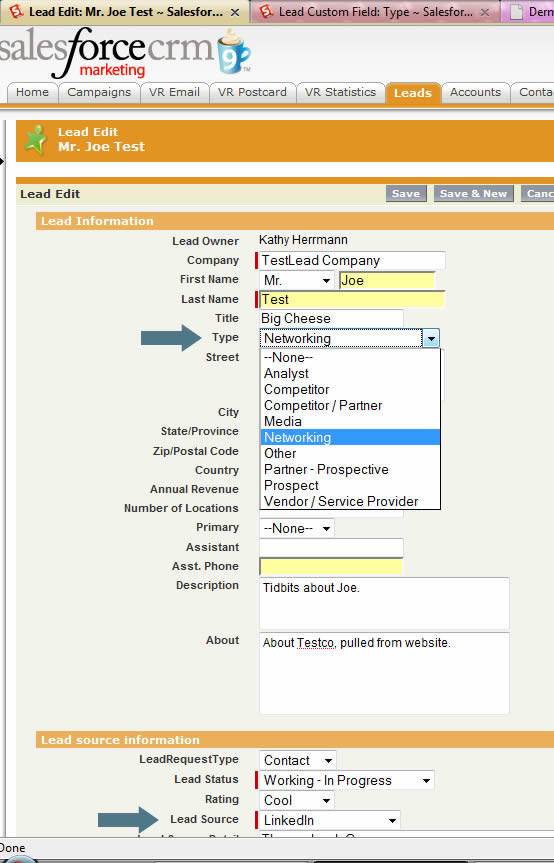 One of my sales buddies made a professional commitment to use LinkedIn more actively as a tool to expand her network and generate leads. She experimented with it the last few months to great success and wants to expand her community involvement.
One of my sales buddies made a professional commitment to use LinkedIn more actively as a tool to expand her network and generate leads. She experimented with it the last few months to great success and wants to expand her community involvement.
She had been entering new LinkedIn connections as Contacts because of the diversity of connections she made, many of whom were not leads. For example, she says her connections span prospective customers, prospective partners, competitors, referral sources, and other miscellaneous networking connections.
I counseled her to enter them all or most of them as Leads instead. Here’s why.
Managing the connection
First, let me explain how my buddy is managing her networking connections because she has a general progression she follows. This will put the Salesforce strategy into perspective. Here’s what she does:
- Issues invitation to connect.
- Once accepted, enters new connection into Salesforce. Gathers some information such as About Company and copy/pastes bits from the person’s LinkedIn profile into the Salesforce record.
- Invites the new connection to meet over the phone.
- Over time, plans to continue to extend professional connection via phone calls, emails, and in-person meetings.
Now, let’s look at a strategy of how to use Salesforce to manage that connection.
Tracking Marketing through Sales
Salesforce.com is a dandy source of business intelligence. However, to gain the most value relative to marketing and sales insights, you have to start with Leads. If you do, then you’ll be able to readily track data like Lead Source, time needed to convert to an Opportunity, and on through to time needed to convert to a sale.
Additionally, Marketing will want to track the best source of Leads, even those generated directly by sales reps. It will be valuable for sales reps and Marketing to know which communities are generating the best conversions. From a sales perspective, reps will want to be able track which communities are the best sources for their leads.
Incorporate consistency in managing community connections. Define business rules around managing community connections in order to incorporate consistency among your sales team. This will allow you to leverage the business intelligence you’ll want to gleam from community mining for sales.
Some connections might truly be Contacts and not Leads
Note, if you clearly recognize that a potential connection is something other than a prospect, for example a competitor, then you may want to enter them directly as a Contact. However, for prospects or folks who you’ll need more time to suss out, your business rule may be to enter them as Leads until you determine the best classification.
Again, it comes back to defining your business rules.
Classify the connection
When you create a new connection into Leads, be sure to classifying it. Depending on how your company elects to set up your Salesforce installation, this may require the creation of a custom picklist field. This field should reflect types of community connections. Additionally, this custom field can also, of course, be used to classify leads by lead-specific categories such as product type.
A short example of the picklist for your Type field may include options to select Prospective customer, Prospective partner, Competitor, Vendor, Networking, etc.
Additionally, your Salesforce administrator will want to be sure to set up the custom field so that it maps into a similar field in your Contact database so you retain the Type data once you convert the lead.
The screenshot below reflects a possible picklist for your Type field.

Another field to consider is a Lead Source field. In a picklist for this, be sure to include your communities of choice as options. These might include LinkedIn, Facebooks, or other online communities, as well as professional associations and trade groups.
Converting the community connection
At some point after you’ve nurtured the community member, you’ll have to decide to convert the lead. If the connection is a non-prospective connection, such as a competitor or a straight networking connection, you may want to convert them to a Contact right away.
Conversely, if the community member is a prospect, then keep them in the Leads database and continue to treat them as any other lead that you nurture as part of your sales and marketing process.
Summary
 It’s all about business intelligence. The more systematic you are in managing your relationships, the more you can give yourself insight into where and how you'll gain the most gold for your sales sweat equity.
It’s all about business intelligence. The more systematic you are in managing your relationships, the more you can give yourself insight into where and how you'll gain the most gold for your sales sweat equity.
After all, you're on the search for a load of nuggets. Not just one.

